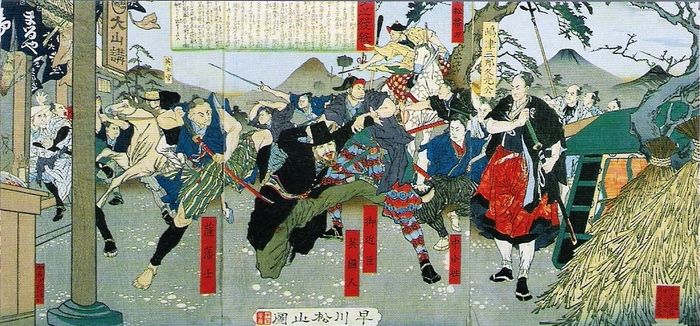Charles L. Richardson (Charles L. Richardson)

British merchant. Namesake of “The Richardson Affair,” known to the Japanese as the “Namamugi Jiken,” the “Namamugi Incident.” Following Commodore Matthew Perry’s forced treaty with the Japanese government, the Dutch, Russians and British quickly established similar agreements. The Japanese governing elite saw the incursion of western traders as inevitable but not entirely welcome. There was at best an uneasy acceptance of the need to do business. During this time, the Emperor required the feudal lords to regularly visit and reside in Edo (now Tokyo)for part of each year. On Sept 4, 1862, Hisamitsu Shimazu, Lord of Satsuma, was on his way to Edo. He was one of the most powerful of the lords, and was the first to embrace western technology and manufacturing methods. Due to his high status, it was not permissible for anyone to overtake his procession. Unaware, or heedless, of this, were Richardson and three companions. At Namamugi, a small town near Yokohama, they rode past Shimazu’s procession without even making obeisance to the lord. This enraged one of Shimzu’s samurais who killed Richardson as two of his companions were wounded. In response to British demandsd for restitution, the Shogunate paid a hundred thousand pounds indemnity, but Satsuma refused to pay indemnity, punish the killers or even make an apology. As a result, British naval ships bombarded the city of Kagoshima on August 15, 1863. As a result of these hostilities, Lord Shimazu was convinced of the superiority of Western military technology. An agreement was reached in which he agreed to punish the murderers of Charles Richardson and recompense his family, and that of the other wounded merchants. Shimazu also negotiated to purchase metal-clad steam-powered warships from the British, which formed the foundation for the formidable Japanese Navy of later years. An alliance was thus forged between the British government and Lord Shimazu of Satsuma, as well as the lord of Choshu. In December that year, eight whole companies of British Royal Marines sailed from Plymouth for Japan, aboard HMS Conqueror. They marched up to Yokohama led by the regimental band. This was, after all, the era of gunboat diplomacy. This show of strength led many of the shogun’s supporters to realise that the days of the shogunate were drawing to a close. Thus was the scene set for the “Meiji Restoration.” (bio by: Warrick L. Barrett)
Born
- January, 01, 1970
- unknown
Died
- September, 09, 1862
Cemetery
- International Cemetery
- Kanagawa
- Japan

